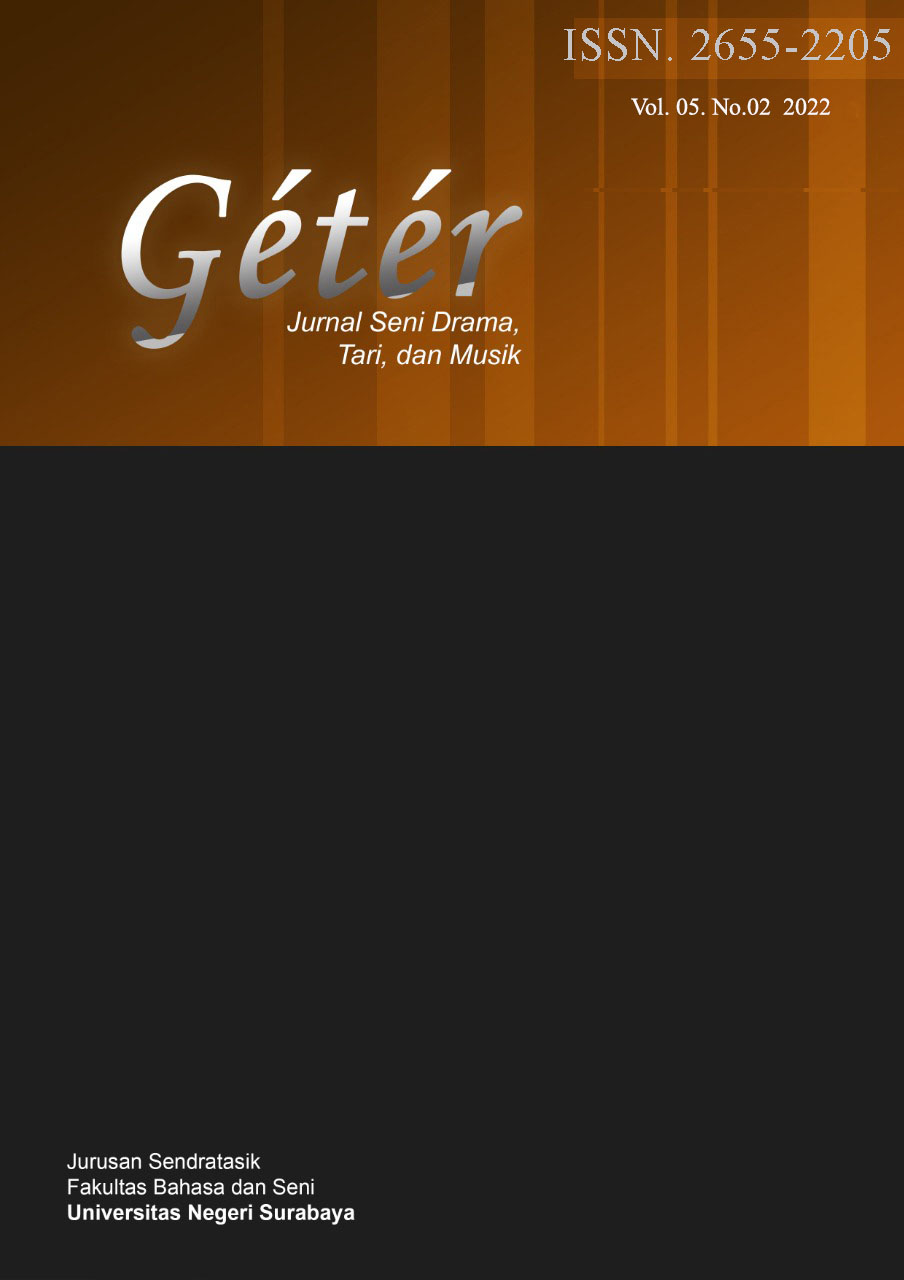DRAMA MUSIKAL; PETER AND THE WOLF (A Symphonic tale for Children) Karya ; Sergei Prokofiev, Op. 67 Sebagai Bentuk Orchestrasi Dongeng
Main Article Content
Abstract
Peter And The Wolf (A Symphonic tale for Children) by Sergei Prokofiev, Op. 67, written by Prokofiev in 1936. The performance of this tale is like a monologue drama. It is rare to find a tale performance or a monologue drama that is composed with music in an ensemble. The narrator tells a children's story, while the orchestra illustrates it using different instruments to play a "theme" representing each character. This work of Prokofiev is one of the works that is often featured throughout the classical repertoire. The storyline is kind of like a Prokofiev biography, depicting Russians living in forest areas. In their cosmic view, the theme "Peter catches the wolf" has the meaning of "man's victory tames Nature". In addition to messages of kindness about vigilance, courage, and resourcefulness, there are also images of the stubborn old Soviet generation (grandfather) and the message of the victory of Man (Peter) in taming Nature (Wolf). Peter and The Wolf are well written score. The interesting thing, it is written in the form of a symphony orchestra, besides having an epic storyline in the spectacle of heroic stories. The theory used from the analysis process to the performance is (deep structures) Richard Schechner in three stages of work, namely: 1). Preparation, 2). Performances, 3). Aftermath. The purpose of research and performance is to find concretization of receptions and concretization of dramaturgy. When the performance transformation is carried out in an Indonesian-language presentation, it is hoped that it will be able to provide semiotic novelty to the target culture for an explanation of the development of Indonesian musical dramas.
Article Details

This work is licensed under a Creative Commons Attribution-ShareAlike 4.0 International License.
kepemilikan artikel milik AutorReferences
Anirun, Suyatna. (2002), Menjadi Sutradara, STSI Press Bandung. Studiklub Teater Bandung bekejasama dengan PUSLITMAS STSI Bandung
Ching, Francis D. K. (2007), Architecture; Form, Space, and Order, New Jersey: John Wiley & Sons, Inc.
Culler, Jonathan, (2003), Barthes, terj. Ruslani, Yogyakarta: Penerbit Jendela.
Damono, Sapardi Djoko. (2012), Alih Wahana, Edisi Revisi Pertama 2012, Editum
Djelantik, A.A.M. (2002), Estetika Sebuah Pengantar, MSPI. Bekerjasama dengan kuBuku, Bandung.
Hays, K. Michael. (1998), Architecture Theory-Since 1968, Massachusetts, USA: Colombia Book of Architecture.
Holt, Claire. (2000), Melacak Jejak Perkembangan Seni Di Indonesia. Bandung: arti.line.
Hutcheon, Linda. (2006), A Theory of Adaptation, London and New York: Routledge Taylor& Francis Group.
Illaihi, Putra Ridho, (2021), Sumpah Suci Anggun Nan Tongga, Indang Piaman Pada Penciptaan Teater Musikal, Jurnal Penciptaan dan Pengkajian Seni, Gestus, Vol.1, No.2, September, 2021.
Isser, Wolfgang, (1978), The Act of Reading; A Theory of Aesthetic Response, London: The Johns Hopkins University Press.
Murgiyanto, Sal. (2016), Pertunjukan Budaya dan Akal Sehat, Fakultas Seni Pertunjukan-Institut Kesenian Jakarta (IKJ), Kerjasama dengan SENREPITA, Yogyakarta.
Nalan, Arthur S. (1998), Mencipta Teater, Sebuah Pengantar Memahami Teater dan Antalogi Naskah Lakon, CV. Geger Sunten, Bandung.
Nalan, Arthur S. (2006), Teater Egaliter. Bandung. Sunan Ambu Press.
Pavis, Patrice. (1992), Theatre at the Crossroads of Culture, London: Routledge.
Rusmana, Tatang. (2018), Rekontruksi Nilai-Nilai Konsep Tritangtu Sunda Sebagai Metode Penciptaan Teater Ke Dalam Bentuk Teater Kontemporer, Jurnal Seni Budaya, Mudra, Volume 33, Nomor 1, Februari 2018, ISI Denpasar.
Rusmana, Tatang. (2011), Makrokosmos Parahiangan dalam Drama Kidung Jakabandung dalam Narasi Metaforik, Strategi, dan Elanvital, Jurnal Ilmiah Seni & Budaya, Panggung, Vol.21 No.3, STSI Bandung.
Schechner, Richard. (2004), Performace Theory, London dan New York: Routledge.
_________________. (2002), Performace Studies: an Introduction, London: Routledge.
Sumardjo, Jakob. (2014), Estetika Paradoks, Kelir, Bandung.
Susanto, N. (2016). Produksi Drama Musikal dari Ide ke Panggung. Jakarta: PT. Grame-dia Pustaka Utama
Suyono, Seno Joko, (2015), Tradisi dan Mitologi Kita: Dari Schechner sampai Julie Taymor, dalam Pendidikan, Birokrasi Seni dan Pergulatan Teater Timur & Barat, 80 Tahun A Kasim Achmad, Pentas Grafika: Jakarta.
Yudiaryani. (2012), Membaca Pendidikan Seni dan Budaya Melalui Pergeseran Paradigma Seni Pertunjukan Teater. Pidato Ilmiah dalam rangka Dies Natalis ISI Yogyakarta ke XXVIII. 30 Mei 2012.
Yunus, Umar, (1985), Resepsi Sastra: Sebuah Pengantar, Jakarta: PT Gramedia.

